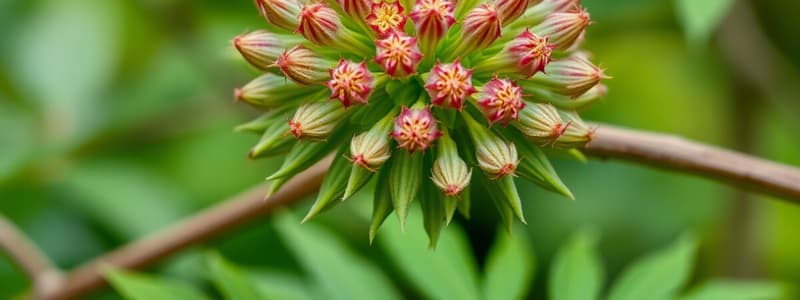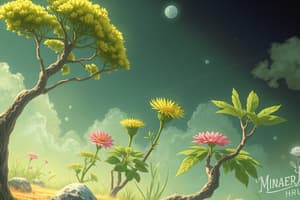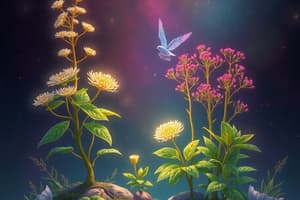Podcast
Questions and Answers
Which of the following best describes the evolutionary significance of seeds?
Which of the following best describes the evolutionary significance of seeds?
- Seeds facilitated plant adaptation to terrestrial environments.
- Seeds promoted the development of gametophytes. (correct)
- Seeds decreased reliance on resources.
- Seeds increased competition among terrestrial ecosystems.
How does heterospory contribute to the adaptations observed in terrestrial plants?
How does heterospory contribute to the adaptations observed in terrestrial plants?
- It allows plants to produce more spores, increasing reproductive output.
- It contributes to genetic diversity.
- It simplifies the fertilization process, making it less susceptible to climate variations. (correct)
- It ensures gametes are always identical, preserving genetic uniformity.
Which statement accurately contrasts gymnosperms and angiosperms regarding their seeds?
Which statement accurately contrasts gymnosperms and angiosperms regarding their seeds?
- Angiosperms and gymnosperms both rely on the same method of seed dispersal.
- Angiosperms evolved before gymnosperms.
- Gymnosperms have seeds enclosed in ovaries, while angiosperms have naked seeds. (correct)
- Gymnosperms produce seeds contained within cones, while angiosperms enclose seeds in fruits derived from ovaries.
What advantage do seeds provide in terms of terrestrial adaptation?
What advantage do seeds provide in terms of terrestrial adaptation?
How does the process of fertilization differ from pollination in plants?
How does the process of fertilization differ from pollination in plants?
What evolutionary advantage is provided by multi flagellated sperm in certain vascular seedless plants?
What evolutionary advantage is provided by multi flagellated sperm in certain vascular seedless plants?
What role do insects play in the evolution of plant pollination?
What role do insects play in the evolution of plant pollination?
Which of the following accurately describes a key adaptation of conifers to terrestrial life?
Which of the following accurately describes a key adaptation of conifers to terrestrial life?
How does the ability of ginkgo trees to change sex influence their survival and propagation?
How does the ability of ginkgo trees to change sex influence their survival and propagation?
How do angiosperms utilize modified leaves for reproduction?
How do angiosperms utilize modified leaves for reproduction?
Why is seed dispersal an important evolutionary adaptation for plants?
Why is seed dispersal an important evolutionary adaptation for plants?
What role does the seed coat play in the adaptation and survival of plants?
What role does the seed coat play in the adaptation and survival of plants?
What is the significance of the discovery of ginkgos in China for understanding plant evolution and conservation?
What is the significance of the discovery of ginkgos in China for understanding plant evolution and conservation?
Which of these is a function of seed adaptations?
Which of these is a function of seed adaptations?
What does homospory in the ancestors of seed plants suggest about the evolution of plant reproduction?
What does homospory in the ancestors of seed plants suggest about the evolution of plant reproduction?
How did the evolution of seed plants affect the Paleozoic era?
How did the evolution of seed plants affect the Paleozoic era?
According to the lecture, besides wind and animals, what else can disperse pollen?
According to the lecture, besides wind and animals, what else can disperse pollen?
What structure does the carpal consist of, and what are their respective functions?
What structure does the carpal consist of, and what are their respective functions?
According to the lecture, which of the following must occur for a seed to germinate?
According to the lecture, which of the following must occur for a seed to germinate?
According to the lecture, what are two requirements for the reproductive adaptations of angiosperms?
According to the lecture, what are two requirements for the reproductive adaptations of angiosperms?
Flashcards
Why are seeds important?
Why are seeds important?
The evolution of seeds changed plant evolution. Seeds enable plants to dominate terrestrial ecosystems.
Natural selection
Natural selection
A natural process where traits change over time, enabling species to adapt to their environment.
What is a seed?
What is a seed?
An embryo and nutrients protected by a coat modified from the previous plant generation.
Reduced gametophytes
Reduced gametophytes
Signup and view all the flashcards
Gymnosperm
Gymnosperm
Signup and view all the flashcards
Megasporangia
Megasporangia
Signup and view all the flashcards
Pollen
Pollen
Signup and view all the flashcards
Pollination
Pollination
Signup and view all the flashcards
Fertilization
Fertilization
Signup and view all the flashcards
Gymnosperms vs. Angiosperms
Gymnosperms vs. Angiosperms
Signup and view all the flashcards
Cycads
Cycads
Signup and view all the flashcards
Multi-flagellated sperm
Multi-flagellated sperm
Signup and view all the flashcards
Ginkgos
Ginkgos
Signup and view all the flashcards
Ephedra
Ephedra
Signup and view all the flashcards
Conifers
Conifers
Signup and view all the flashcards
Flower in angiosperms
Flower in angiosperms
Signup and view all the flashcards
Flower anatomy
Flower anatomy
Signup and view all the flashcards
Fruit
Fruit
Signup and view all the flashcards
Fruit and Seed Coevolution
Fruit and Seed Coevolution
Signup and view all the flashcards
Seed Germination
Seed Germination
Signup and view all the flashcards
Study Notes
Seeds and Plant Evolution
- Seeds changed plant evolution
- Seed evolution has been an effect, not a cause
- Natural selection isn't a direct cause-and-effect
- Seeds enabled the evolution of terrestrial plant ecosystems
Plant Adaptation to Land
- Plants moved to land for available resources
- Plant adaptation to land is exemplified by the seed
- A seed contains a baby, embryo and nutrients surrounded by a protective coat genetically modified from the previous plant
- Gametophytes are reduced in seed plants
- Gamete heterospory is common in seed plants
- Ovules and pollen contribute to the production of terrestrial life
Plant Group Evolution
- Gymnosperms and angiosperms are unique plant groupings.
- Seed plants are divided into gymnosperms and angiosperms.
- Gymnosperms appeared early in the fossil record
- Sperm types determined better suitability of plants to drier conditions
- Angiosperms evolved later from general sperms
- Ancestors of seed plants were likely homosporous
- Seed plants are generally heterosporous but not absolute.
Megaspores and Microspores
- Megasporangia produces megaspores that produce the female gametophytes of the seed.
- Microsporangia produce microspores that give rise to the male gametophytes or the sperm (pollen).
- A megasporangium contains food and nourishment for the developing embryo.
- The megaspore supplies nourishment after meeting the microspore.
- Pollination and fertilization are different.
- Pollination is when pollen comes together
- Fertilization is when n becomes n+n
- Seeds evolved to provide evolutionary advantages
- Seeds can stay dormant for a long time, be buried, or be eaten and dispersed
- Seeds dispersed by animals aid in adaptation to the terrestrial environment.
Gymnosperm Reproduction
- Gymnosperms have naked seeds, not enclosed by ovaries (fruits).
- Four groups of gymnosperms: Cycads, Ginkgo biloba, Gnetales, and Conifers.
- Gymnosperms thrived during the Mesozoic era.
- Relatively few species exist today due to competition
- Dinosaurs consumed gymnosperms during dinosaur times
Gymnosperm Sperm
- Multi-flagellated sperm are present in some gymnosperms
- Insects play a part in pollinating geminal sperms
- Plants transfer pollen when they eat the pollen
- Pollination became widely developed with angiosperms
Conifers
- Conifers have adapted to conserve moisture, allowing survival in dry conditions.
- Foliage is modified in conifers for water conservation
- Conifers have special adaptations, such as needles, coated for winter weather
- Conifers use windblown seeds for offspring dispersal, but it may also be carried by animals and floods
- Heterosporous plants have separate male and female parts of the flower.
Glaciers and Gymnosperm
- The surface of glacial alps is younger than material underneath due to glacial carving
- Bristlecone pines live for thousands of years, and are incredibly aging
- Some trees have been unchanged since the Jurassic period
Conifer Life Cycle and Reproduction
- Conifers are replanted after being cut down
- Some gymnosperms don't maintain leaf structure for photosynthesis
- Pioneers often misidentified trees
- Native Americans made pemmican using Juniper berries
- The sporophyte supports the gametophytes
- Cones produce the babies via meiosis, and they produce pollen grains
- Pollen grains go through meiosis and move into the micropyle for pollination
Seed dispersal
- Ovules are contained in the sporophyte cones
- The development of the baby plant (fertilization) is started biochemically by the pollen attaching to the micropile
- Seeds provide food for the baby plant
- Naked seeds don't have fruit, so they rely on coatings for this
- Seeds get planted when they fall near the tree, or vector carries them a distance away
Seed Survival
- Seeds are dispersed by animals that eat them.
- Seeds are dispersed by other environmental factors, such as wind and water
Plant Genetics
- Pando is what the Aspen tree colonies are know as Pando - Aspen tree colonies: a singular organism
Angiosperms - Flowering Plants
- Angiosperms have ovaries, which produce fruits
- Flowers and fruit are reproductive adaptations of angiosperms
- Flowers: reproductive structures that produce petals, sepals, and other parts
- Angiosperms evolved from gymnosperms, and are successful due to rapid and effective reproduction
- Animals and insects pollinate many angiosperm species
- Other angiosperms make use of water
- Angiosperms have a flower; a specialized shoot with 4 types of modified leaves
- Sepals protect the flower while it develops.
- Petals attract pollinators.
- Stamens produce pollen on their terminal anthers. A carpal consists of an ovary
- Pollen is received.
- Fruit derives from a mature ovary, and it provides nursery to the babies.
- Fruits can contain other flower parts.
Seed Survival Strategy
- Fruit protects seeds and aids in their dispersal.
- Some seed coats needed protection to go through the digestive tract, and need resistant digestive enzymes
- Seed coats withstand the low pH or digestive enzymes in the acidity in the stomach
- Some seeds need disruption of the seed coat in order to germinate; scarification or scraping
Studying That Suits You
Use AI to generate personalized quizzes and flashcards to suit your learning preferences.
Related Documents
Description
Learn about the role of seeds in plant evolution and adaptation to terrestrial environments. Explore gametophyte reduction, gamete heterospory, and the significance of ovules and pollen. Discover the evolutionary paths of gymnosperms and angiosperms, highlighting sperm types and adaptations to drier conditions.




